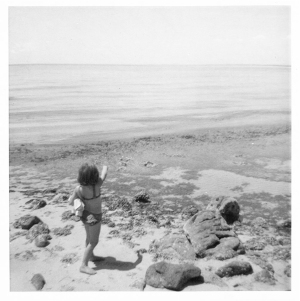The first review of my novel was published last week (in Books+Publishing Reviews, 30 May 2013, reproduced here with permission), and reviewer Katie Haydon (who gave it four stars) said it would be appreciated particularly by, among others, “lovers of the sea”. I’m pleased she mentioned that. Water flows through the novel; it’s almost a character in it. It’s of central importance to the novel’s main character, Lena Gaunt.
And for me? I have a complicated relationship with the sea. I was slightly scared of it as a child. That’s long-ago me in the photo, pointing to where the baby whale was, one of those childhood episodes that didn’t help: if the baby whale was down there, then surely the mother whale was too; and if they were, then what else was there that I couldn’t see? And so it went, in a terrible spiral, fed by The Tale of Mr. Jeremy Fisher and topped off by Jaws. I remain, as an adult, respectful and a little bit nervous of the sea. It’s intriguing to me, fascinating, but — unlike Lena — I prefer to keep it at a distance, or as a concept, rather than needing to be immersed in it. The sea is a central focus in a lot of my writing — not just this novel, but in short stories like ‘Surface Tension’, ‘The Wee Three Kings’, ‘Yargnits’, ‘Blessed’, ‘The Action of Water’, and ‘Dissolve’. It’s almost (almost?!) an obsession. It’s certainly an inspiration.
Writing The Life and Loves of Lena Gaunt, I knew that water was important for Lena. She’s a musician, so I wanted to play around with ideas of ocean waves and sound waves. I wanted sound waves to be present in the ocean waves, as they are in the opening of the novel, when Lena — an old woman — is swimming, and noticing sound and movement and connections.
I move my arms in wide arcs in front of me, pushing water out to the sides and back again. I can feel the stretch in my shoulders, the tendons tense and twist. Bubbles form up my arms, trapped in the tiny pale hairs, tickling like the bead in champagne. Moving my fingers in the water effects tiny changes in the waves that effect bigger movements. Action at a distance; just like playing the theremin.
In the novel, water becomes a healing medium for Lena; it’s her ritual and her release. In narrative and geographic terms, the sea both separates and links the different chapters of Lena’s life. It’s where the novel starts, and ends: with the old woman, and the sea.
